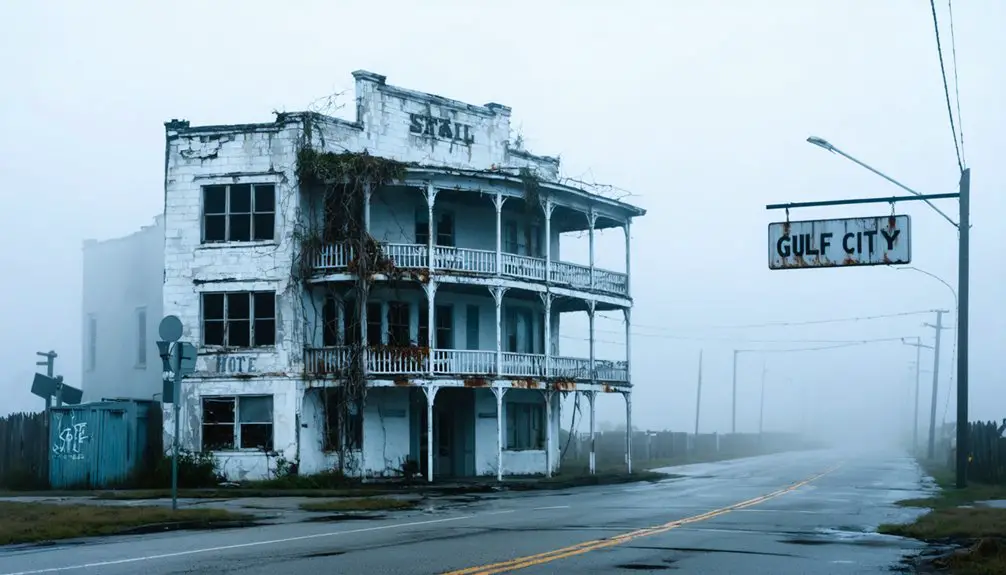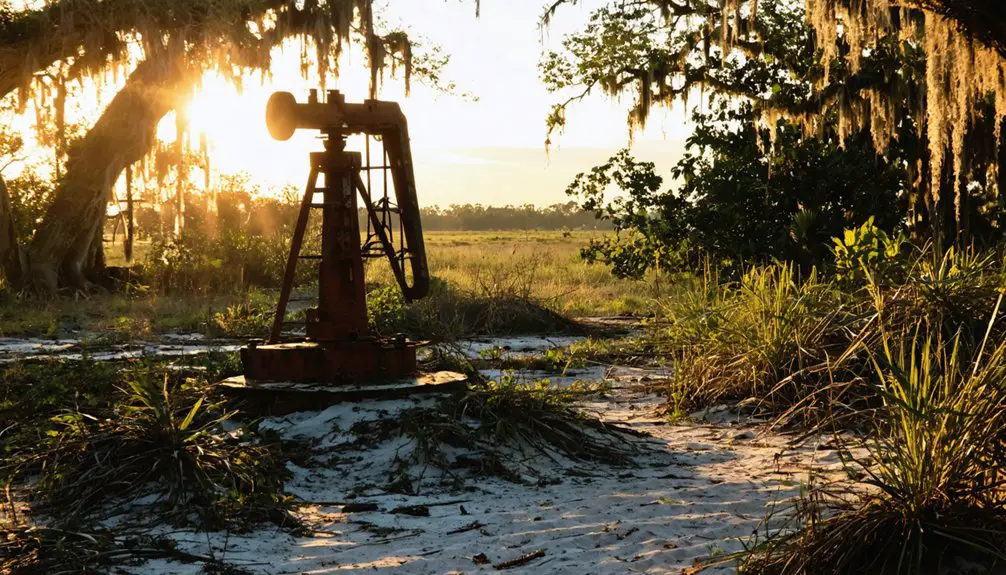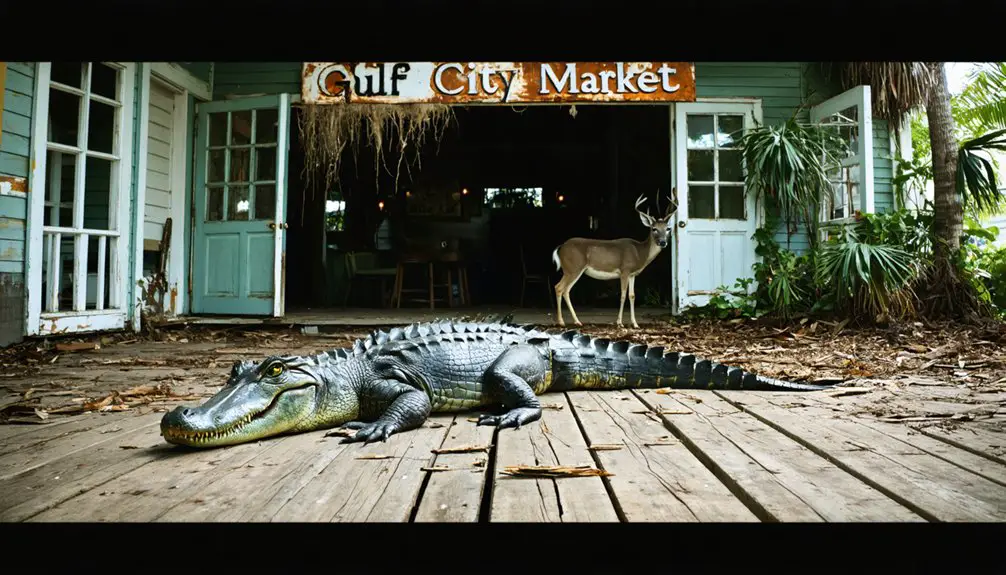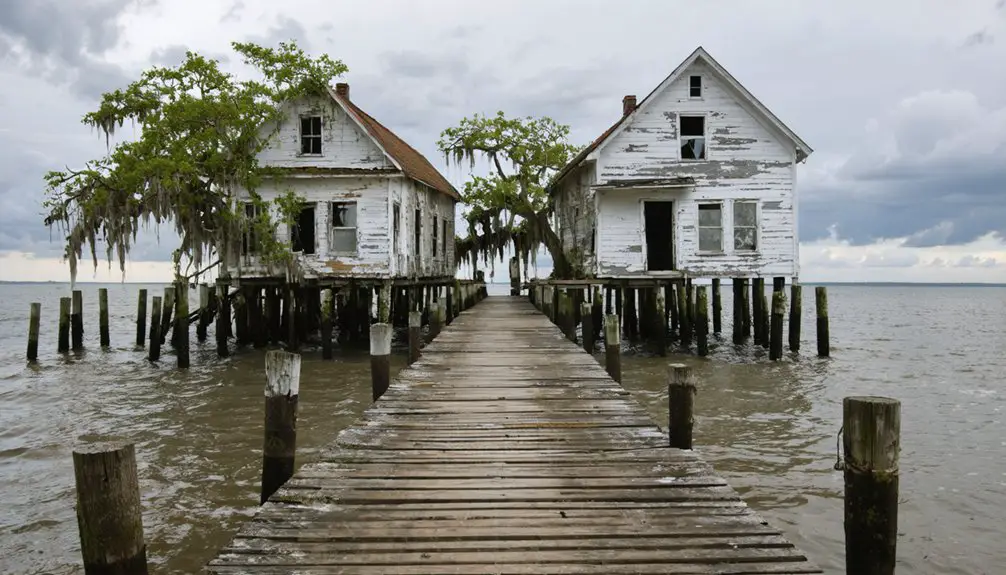You’ll find Gulf City’s remains along Florida’s Little Manatee River, where this former pirate fishing port later became a thriving oyster industry hub with 76 residents. In the late 1800s, Ben Moody’s oyster operations employed dozens while northern sport fishermen brought wealth to local businesses. Though absorbed by Ruskin in 1908, Gulf City’s fascinating transformation from maritime haven to ghost town holds centuries of untold stories beneath its modern marina development.
Key Takeaways
- Gulf City was a small Florida settlement of 76 residents that thrived on oyster fishing before being absorbed by Ruskin in 1908.
- The town transformed from a pirate fishing port to a wealthy sport fishing destination after the Civil War.
- Ben Moody’s oyster and sardine operations employed 30-40 workers, forming the economic backbone of Gulf City’s final inhabited years.
- The Lost Hotel served tourists until the area’s development into Paradise Village, marking Gulf City’s transition from settlement to ghost town.
- Modern urban development has erased most physical evidence of Gulf City, though its history lives on through digital archives and museums.
The Legend of Pirate Ben Margoza
While many legendary pirates have shaped Florida’s coastal history, few tales are as intriguing as that of Ben Margoza, the “Pious Pirate” who allegedly began as an English priest loyal to King Charles I in the 1640s.
After fleeing to Virginia during Cromwell’s reign, he turned to piracy but maintained his religious convictions, famously refusing to battle on Sundays.
You’ll find Margoza’s legacy intertwined with Gulf City, Florida, where he supposedly established a pirate stronghold in the mid-17th century. Near his rumored hideout, archeologists have discovered numerous native village artifacts along the Little Manatee River. Like many pirates of his era, he participated in the slave trading of Indigenous people.
After Cromwell’s fall, stories suggest he returned to England and received knighthood from Charles II.
Though historical records can’t verify these accounts, treasure hunters still search Gulf City’s abandoned grounds, hoping to discover buried chests and perhaps encounter ghostly remnants of this peculiar priest-turned-pirate’s tale.
Native American Settlements Along Little Manatee River
You’ll find evidence of the Uzita people’s 10,000-year presence along the Little Manatee River through the remains of 7 aboriginal mounds concentrated within a 3-mile stretch.
The Thomas Mound, though now destroyed, yielded artifacts that revealed extensive Native American hunting and fishing activities, including shell cups, pottery shards, and European trade items like beads and copper.
These archaeological sites paint a picture of thriving indigenous communities who built sophisticated structures, including temple mounds and chiefs’ houses, while sustaining themselves through the river’s abundant fishing grounds and the surrounding wilderness. The Uzita people were skilled at fishing and clamming, leaving behind substantial shell deposits that were used for their burial mounds. Manatee County’s Historic Preservation Board works to protect these significant archaeological sites through regular surveys and inventories of remaining artifacts.
Archaeological Evidence Timeline
Archaeological evidence reveals that Native American settlements along Florida’s Little Manatee River flourished between 900 to 1200 CE, spanning the Late Woodland to early Mississippian periods.
Through careful archaeological techniques, researchers have uncovered extensive settlement patterns, including distinctive oyster shell ridges up to 4 meters tall that enclosed residential spaces. Modern excavation teams employ ground penetrating radar to identify subsurface features without disturbing the site. Archaeologists have discovered numerous ancient burial sites that provide valuable insights into the community’s cultural practices.
You’ll find organic midden layers extending 60-70 cm deep, packed with vertebrate remains and pottery fragments that point to permanent habitation rather than temporary camps.
The settlement’s complexity is evident in rectangular enclosures and pit features beneath midden deposits, suggesting sophisticated social organization.
A nearby mound, later used as a 19th-century lookout, demonstrates the site’s strategic importance across multiple periods of occupation.
Hunting and Fishing Grounds
Along the Little Manatee River, the Uzita tribe established sophisticated hunting and fishing practices that shaped their cultural identity and survival strategies.
You’ll find evidence of their resourceful lifestyle in the shell middens and mounds that still dot the landscape, showcasing their deep connection to both river and Gulf waters.
- Uzita fishing practices incorporated nets and traps in the river’s ecosystem, while gathering clams and shellfish in the rich estuarine waters. Today, visitors can explore Camp Bayou’s exhibits that demonstrate these traditional fishing methods.
- The tribe’s hunters tracked deer, turkey, and small game through pine flatwoods and palmetto landscapes.
- They shared contested hunting grounds with the Calusa, particularly in the Great Swamp area.
- Their settlements balanced seasonal movement patterns with sustainable resource management, ensuring long-term survival along the waterways. Like other tribes in the region, they cultivated the three sisters as a crucial part of their diet and agricultural practices.
Rise of a 19th Century Fishing Paradise
Located at the mouth of the Little Manatee River, Gulf City first gained prominence as a bustling pirate fishing port before transforming into a sophisticated destination for wealthy sport fishermen.
The area saw an influx of northern fishermen seeking new productive fishing grounds in the post-Civil War era.
Local fishermen constructed their own flat-bottomed skiffs that were perfectly suited for navigating the shallow coastal waters.
You’d find the town’s grand hotel catering to affluent anglers who traveled from across the country to experience the legendary fishing grounds.
The Little Manatee River’s abundant fish populations, including snook, tarpon, and mullet, made Gulf City one of Florida’s premier 19th-century fishing destinations, with historical accounts documenting remarkable catches of up to 500 mullet per hour.
Pirate Port Fishing Beginnings
Before becoming a bustling commercial fishing hub, Gulf City’s waters teemed with diverse marine life that attracted both indigenous peoples and early European settlers.
You’d have found ancient fish weirs near river mouths, where Native Americans crafted oyster-shell enclosures to trap fish during tide changes – a proof of their ingenuity that predated any pirate fishing operations in this future ghost town.
- The waters held mullet, flounder, jewfish, redfish, shark, snook, and the prized tarpon.
- Local fishermen mastered beach netting, hauling hundreds of fish onto shore in single catches.
- During peak seasons, fish were so plentiful that prices dropped to mere pennies per pound.
- Indigenous peoples maintained sophisticated impoundments and tidal traps in coastal lagoons, sustaining their communities long before commercial exploitation began.
Hotel Attracts Wealthy Sportsmen
When Gulf City‘s ambitious promoters constructed a two-story hotel atop a native mound at Shell Point Road’s end in the late 19th century, they transformed the humble fishing village into a sought-after destination for wealthy sportsmen.
The hotel’s historical impact extended beyond simple lodging – it marked Gulf City’s evolution from a working fishing community into a recreational paradise.
You’d have found the establishment complementing Ben Moody’s thriving oyster and sardine operations, which employed 30-40 workers.
The economic transformation brought by affluent visitors created new opportunities in hospitality while diversifying the local economy.
From the hotel, you could access the rich fishing grounds of Tampa Bay and the Little Manatee River, making Gulf City an early pioneer in the region’s recreational fishing tourism – a model that would later inspire other Gulf Coast communities.
Little Manatee River Bounty
The Little Manatee River’s pristine waters drew more than just hotel guests to Gulf City’s shores – it represented one of Florida’s richest fishing grounds, built upon thousands of years of maritime heritage.
You’d find yourself following in the footsteps of the Uzita tribe, who mastered these waters over 10,000 years ago, in a river that’s maintained its natural blackwater ecology largely unchanged.
- Commercial fishing techniques flourished here, particularly mullet fishing, supporting bustling fish houses and fleets.
- Early settlers combined fishing with tomato and citrus farming along the fertile riverbanks.
- River ecology remained pristine without the industrial dredging common elsewhere in Florida.
- Local fish stocks were so abundant that conservation groups formed to protect this natural bounty, leading to game laws and sustainable fishing practices.
The Lost Hotel at Shell Point Road

Located along Shell Point Road in what was once a bustling fishing and camping destination, the Lost Hotel served as a cornerstone of early 20th-century tourism despite leaving few physical traces today.
The hotel thrived during an era when Shell Point attracted visitors from North Florida, Georgia, and Alabama who sought its white sand beaches and abundant seafood.
You’ll find that before the Lost Hotel’s time, the area offered only basic amenities like a café, icehouse, and rustic camp cabins.
While detailed records of the hotel remain sparse, oral histories suggest it played a crucial role in the local tourism economy alongside fishing camps and oyster harvesting.
The hotel’s eventual abandonment and demolition preceded the area’s transformation in the 1960s into Paradise Village, a mobile home community.
Bridge to Tampa: A Vanished Connection
As you travel along Shell Point Road today, you’ll notice no trace of the river crossing that once connected Gulf City to Tampa’s bustling commercial district.
The Fortune Street Bridge‘s construction near Gulf City’s waterfront in the late 1800s established an essential transportation link that supported West Tampa’s thriving cigar industry.
You can still spot remnants of the old bridge footings at low tide, serving as silent witnesses to Gulf City’s former role as an important waypoint between Tampa and the Gulf Coast settlements.
Lost River Crossing
During Tampa’s early development, critical bridge connections across the Hillsborough River faced recurring challenges, from Seminole attacks in the 1830s to natural deterioration.
The historical significance of these river crossings shaped Tampa’s growth and defense strategy, leading to the establishment of key military outposts like Fort Foster in 1836.
- You’ll find remnants of early crossing points where ferries first operated in 1846, opening new paths for Tampa’s expansion.
- You can trace the evolution from wooden bridges vulnerable to destruction to industrial-era improvements.
- You’ll discover how the 1897 electrical dam installation marked a turning point in infrastructure development.
- You’re walking in the footsteps of settlers who relied on these crossings for trade, travel, and survival.
These lost connections tell a story of Tampa’s resilience and determination to maintain essential transportation links.
Early Travel Routes
The Tampa Bay region’s transportation landscape before the 1920s centered on a patchwork of ferries and boats, with Hayden’s Ferry serving as a primary connection point across the Hillsborough River since 1885.
You’d have found the early travel infrastructure quite limited, relying heavily on ferry crossings until visionaries like John Ingraham proposed building bridges in 1887.
While the U.S. Army Corps of Engineers initially opposed some bridge plans due to navigation concerns, growing railroad commerce and population demands eventually pushed development forward.
The breakthrough came in 1924 with the Gandy Bridge, transforming the region’s connectivity as the world’s longest toll bridge. This engineering marvel, built with 3 million tons of concrete, replaced slower ferry routes and opened up unprecedented freedom of movement between Tampa and St. Petersburg.
Archaeological Treasures of Leisey Shell Pit

Located 7 kilometers southwest of Ruskin near Cockroach Bay, Florida’s Leisey Shell Pit stands as one of Earth’s most celebrated early Ice Age fossil sites.
When you explore this treasure trove dating back 1.5 to 1 million years ago, you’ll discover a site that’s revolutionized our understanding of Florida’s prehistoric past.
- Over 50,000 fossils emerged from Leisey Pit, including saber-toothed cats, mammoths, and giant ground sloths.
- You can find evidence of 73 fish species, making it Florida’s largest early Pleistocene fish collection.
- The site’s unique “Leisey Condor” fossil represents a remarkable avian discovery.
- Public volunteers helped unearth more than 20,000 identifiable vertebrate specimens during a six-month dig in 1984.
Today, while the pit lies partially flooded, its fossil discoveries continue to enlighten researchers through displays at the Florida Museum of Natural History.
From Bustling Port to Abandoned Waters
Established in 1835 as St. Joseph, this ambitious port city emerged as Florida Territory’s largest settlement, boasting a natural harbor deeper than its rival Apalachicola.
You’ll find evidence of its historical trade prominence in the remains of 4,000-foot wharves and Florida’s first steam railroad, which connected Depot Creek to St. Joseph Bay.
At its peak in 1837, nearly 11,000 residents drove a bustling economy exporting cotton, naval stores, and lumber.
In 1837, a booming population of 11,000 fueled St. Joseph’s thriving export trade of cotton, lumber, and naval supplies.
But the city’s economic resilience faced devastating blows: yellow fever epidemics, a catastrophic fire, and a destructive hurricane struck in rapid succession.
These disasters transformed the thriving port into a ghost town, leaving only a handful of hunters and fishermen.
Though Port St. Joe later reemerged in 1909 with industrial focus, it never reclaimed its original maritime glory.
Wildlife Reclaims the Ghost Town

As nature gradually reclaims Gulf City’s abandoned structures, you’ll discover a remarkable transformation that started long before human settlement.
The wildlife resurgence brings the area full circle, returning it to a natural state reminiscent of its prehistoric past when saber-tooth cats and giant sloths roamed these shores.
- You’ll find gopher tortoises creating burrows that support multiple species, establishing an ecological balance in the abandoned landscape.
- Native predators like bobcats and Florida panthers now stalk through overgrown pathways where port workers once walked.
- The Little Manatee River teems with fish while river otters play along its banks.
- Migratory birds soar above the encroaching mangroves and saw palmettos that steadily consume the remnants of human habitation.
The ghost town has become a living museum of Florida’s natural heritage, protected by its very abandonment.
Merging Into Modern-Day Ruskin
While Gulf City’s remnants slowly faded into history, the growing town of Ruskin emerged as the area’s dominant settlement after its founding in 1908.
You’ll find Gulf City’s historical significance preserved mainly in memory, as its once-thriving oyster industry and small community of 76 residents gave way to Ruskin’s planned development and agricultural boom.
The economic shift was stark – where Gulf City’s fishing economy had faltered, Ruskin flourished with diverse industries including sawmills, turpentine stills, and vegetable farming.
The community identity changed as Ruskin absorbed Gulf City’s territory and remaining population.
Today, you won’t find much physical evidence of Gulf City’s cultural heritage, as modern housing developments and a marina now occupy its former location along the Little Manatee River, completing its transformation into a residential zone within Ruskin’s expanding borders.
Preserving Gulf City’s Hidden History
Despite Gulf City’s physical structures having vanished, the area’s rich archaeological and paleontological heritage continues to captivate researchers and historians.
You’ll find the region’s hidden artifacts and underwater preservation efforts centered around the Leisey Shell Pit, Florida’s most significant paleontological site.
- Over 30,000 prehistoric animal bones, including saber-tooth cats and giant sloths, have been recovered from the submerged pit.
- Native American villages once thrived at the Little Manatee River’s mouth, leaving behind thousands of years of cultural evidence.
- Frank Garcia’s fossil collection remains viewable at Camp Bayou Nature Preserve.
- Digital archives and interpretive signs help preserve Gulf City’s story, despite limited physical access to the original town site.
The area’s prehistoric treasures and indigenous heritage live on through museum displays, guided tours, and protected natural habitats.
Frequently Asked Questions
What Was the Average Property Value in Gulf City During Its Peak?
While Gulf County’s modern homes average $235,700, you won’t find reliable historical data on Gulf City’s peak property values. The town’s historical significance faded before detailed real estate records were standardized.
How Many Children Attended Gulf City’s School Before Its Closure?
While exact school attendance records haven’t survived, you’ll find historical patterns suggest Gulf City’s education history likely included fewer than 100 students when the small rural school closed its doors.
What Diseases or Epidemics Affected Gulf City’s Population?
You won’t find documented evidence of specific disease outbreaks affecting Gulf City’s population. While diseases were common in 19th century Florida settlements, historical records don’t link any epidemics to Gulf City’s population decline.
Did Gulf City Have Its Own Local Newspaper or Publication?
Like footprints in the sand, Gulf City’s local journalism presence remains elusive. You won’t find historical publications specific to Gulf City – neighboring Tampa’s newspapers, including the Tampa Morning Telegraph, served the area instead.
What Were the Most Common Occupations Among Gulf City’s Female Residents?
You’ll find women in Gulf City primarily worked as domestic servants, textile workers handling sewing and laundry, while others took on community roles supporting local farms, fishing operations, and hospitality services.
References
- https://www.ospreyobserver.com/2020/11/south-countys-first-village-remembered-the-ghosts-of-gulf-city-first-town-south-of-alafia/
- https://freepages.history.rootsweb.com/~gtusa/usa/fl.htm
- https://cccourthouse.org/wp-content/uploads/2023/12/Ghost-towns-and-Cemeteries-of-Citrus-County.pdf
- https://www.ghosttowns.com/states/fl/gulfcity.html
- https://en.wikipedia.org/wiki/List_of_ghost_towns_in_Florida
- https://tropicaltreasurehunt.com/tropical-tribune/pirate-legends-and-myths-of-the-tampa-bay-area-part-1/
- https://www.ospreyobserver.com/2020/05/claiming-our-history-the-legend-of-john-ortiz-little-manatee-river-landing/
- https://ghosttownadventures.wordpress.com/2016/03/07/gulf-city/
- https://www.youtube.com/watch?v=89yENhluDEc
- http://campbayou.pbworks.com/w/file/fetch/103561361/UzitaResearchPaper.pdf



